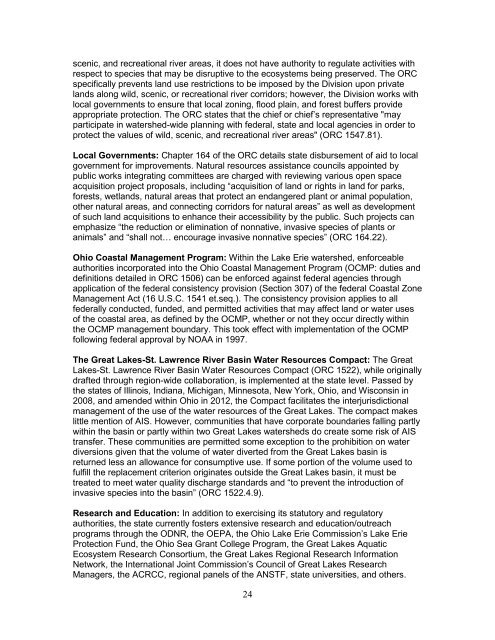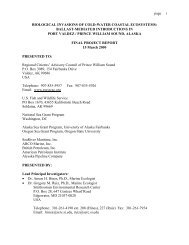State Management Plan for Aquatic Invasive Species Ohio ...
State Management Plan for Aquatic Invasive Species Ohio ...
State Management Plan for Aquatic Invasive Species Ohio ...
You also want an ePaper? Increase the reach of your titles
YUMPU automatically turns print PDFs into web optimized ePapers that Google loves.
scenic, and recreational river areas, it does not have authority to regulate activities with<br />
respect to species that may be disruptive to the ecosystems being preserved. The ORC<br />
specifically prevents land use restrictions to be imposed by the Division upon private<br />
lands along wild, scenic, or recreational river corridors; however, the Division works with<br />
local governments to ensure that local zoning, flood plain, and <strong>for</strong>est buffers provide<br />
appropriate protection. The ORC states that the chief or chief’s representative "may<br />
participate in watershed-wide planning with federal, state and local agencies in order to<br />
protect the values of wild, scenic, and recreational river areas" (ORC 1547.81).<br />
Local Governments: Chapter 164 of the ORC details state disbursement of aid to local<br />
government <strong>for</strong> improvements. Natural resources assistance councils appointed by<br />
public works integrating committees are charged with reviewing various open space<br />
acquisition project proposals, including “acquisition of land or rights in land <strong>for</strong> parks,<br />
<strong>for</strong>ests, wetlands, natural areas that protect an endangered plant or animal population,<br />
other natural areas, and connecting corridors <strong>for</strong> natural areas” as well as development<br />
of such land acquisitions to enhance their accessibility by the public. Such projects can<br />
emphasize “the reduction or elimination of nonnative, invasive species of plants or<br />
animals” and “shall not… encourage invasive nonnative species” (ORC 164.22).<br />
<strong>Ohio</strong> Coastal <strong>Management</strong> Program: Within the Lake Erie watershed, en<strong>for</strong>ceable<br />
authorities incorporated into the <strong>Ohio</strong> Coastal <strong>Management</strong> Program (OCMP: duties and<br />
definitions detailed in ORC 1506) can be en<strong>for</strong>ced against federal agencies through<br />
application of the federal consistency provision (Section 307) of the federal Coastal Zone<br />
<strong>Management</strong> Act (16 U.S.C. 1541 et.seq.). The consistency provision applies to all<br />
federally conducted, funded, and permitted activities that may affect land or water uses<br />
of the coastal area, as defined by the OCMP, whether or not they occur directly within<br />
the OCMP management boundary. This took effect with implementation of the OCMP<br />
following federal approval by NOAA in 1997.<br />
The Great Lakes-St. Lawrence River Basin Water Resources Compact: The Great<br />
Lakes-St. Lawrence River Basin Water Resources Compact (ORC 1522), while originally<br />
drafted through region-wide collaboration, is implemented at the state level. Passed by<br />
the states of Illinois, Indiana, Michigan, Minnesota, New York, <strong>Ohio</strong>, and Wisconsin in<br />
2008, and amended within <strong>Ohio</strong> in 2012, the Compact facilitates the interjurisdictional<br />
management of the use of the water resources of the Great Lakes. The compact makes<br />
little mention of AIS. However, communities that have corporate boundaries falling partly<br />
within the basin or partly within two Great Lakes watersheds do create some risk of AIS<br />
transfer. These communities are permitted some exception to the prohibition on water<br />
diversions given that the volume of water diverted from the Great Lakes basin is<br />
returned less an allowance <strong>for</strong> consumptive use. If some portion of the volume used to<br />
fulfill the replacement criterion originates outside the Great Lakes basin, it must be<br />
treated to meet water quality discharge standards and “to prevent the introduction of<br />
invasive species into the basin” (ORC 1522.4.9).<br />
Research and Education: In addition to exercising its statutory and regulatory<br />
authorities, the state currently fosters extensive research and education/outreach<br />
programs through the ODNR, the OEPA, the <strong>Ohio</strong> Lake Erie Commission’s Lake Erie<br />
Protection Fund, the <strong>Ohio</strong> Sea Grant College Program, the Great Lakes <strong>Aquatic</strong><br />
Ecosystem Research Consortium, the Great Lakes Regional Research In<strong>for</strong>mation<br />
Network, the International Joint Commission’s Council of Great Lakes Research<br />
Managers, the ACRCC, regional panels of the ANSTF, state universities, and others.<br />
24














